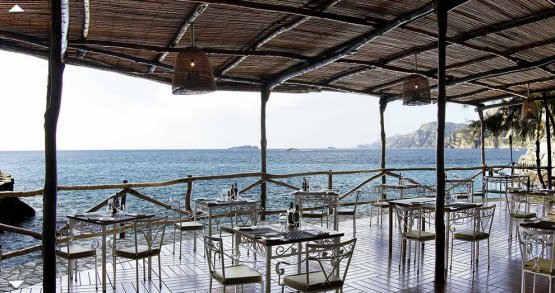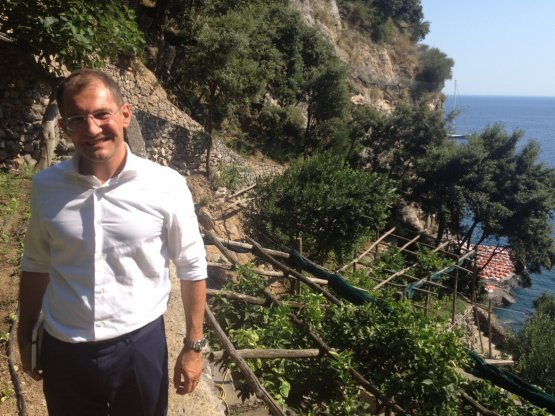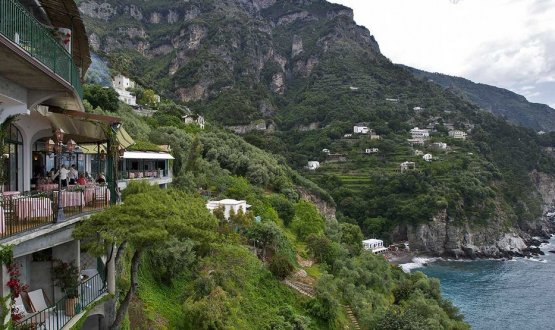Of course, when offered spaghetti seasoned with sea urchins with the sea swishing in the background, the light breeze wrapping the sea stacks of Capri and Li Galli two hours away you wouldn’t just want to leave. But you happily regain your composure to ride the vertical line separating restaurant Il Carlino on the beach, from the main structure of hotel San Pietro, 88 metres above. Were not the lift built into the rocks but opened the view on the scenic amphitheatre of terraced vegetable gardens that unite the two levels, you’d completely forget what you’re leaving. However, oblivion arrives right after that, sitting on the terrace of the Zass, the main restaurant, located on a terrace that wakes up every day greeted by the houses clinging to Positano, a couple kilometres of sea away.
Since 2003 this has been the kingdom of Belgian Alois Vanlangenaeker, a chef who has critics and public agree, two parallel lines that in Italy seem to meet only towards the infinite. He’s a very reserved chef, so discreet only few acknowledge a merit of his, that is that he led Don Alfonso in Sant’Agata dei due Golfi to three stars, the only restaurant in the history of Campania that has shined for some time with the highest reward.
Good morning chef, what led you to Italy in 1992?
My first Belgian master, Roger Souvereyns, a great chef [previously with two Michelin stars at Scholteshof in Stevoort]. He always went on holiday in the Peninsula and he encouraged me to have some experience here. I learnt an essential lesson from him: in the kitchen you have to be strict. It’s unavoidable. If a guy arrives late or with a beard from the previous day you need to shout. The first time he will be upset; the second time he won’t do it.

Il Carlino, the restaurant at sea level inside hotel San Pietro. The restaurant is named after the founder of the resort, Carlino Cinque, grandfather of the current owner Vito Cinque
I arrived as kitchen manager in 1992 and stayed until 2000. Unforgettable years. We conceived great dishes such as
Vesuvio di Rigatoni, the Tuna mousse, the Lemon concert. The third star arrived in 1997. A great joy.
The stars were once again two in November 2001.
Yes, unfortunately. Alfonso Iaccarino did not forgive me for leaving. This made me very sad because to me he was like a father. I think he’s still upset with me but this is not a war I fed. I’m a calm guy, I think about my job.
Where did you go after that?
To Japan, at
Mikuni in Tokyo. A fantastic experience. There were very few really good Italian chefs there, perhaps only at
Enoteca Pinchiorri. After that I moved for 2 years and a half to
La Pinède in Saint Tropez. They wanted me to stay. But the lifestyle there was too quick and perverse to my liking. In 2003 I met Vito Cinque, he asked me to work for a season to change the restaurant offer of the San Pietro hotel, I accepted to return and 11 years later I’m still here.
There was already one star and this has been the case to this day. Is this a problem for you?
Of course not. It’s a choice. The owners know perfectly well what I think: it’s best to have a restaurant with one star but full, every day, than one with two stars half or even one third full. During the season we have 120 guests almost every night. We have no fear of distributing the guests in 3 shifts: 5.30, 8 and 10.30 pm. In France this is not a scandal for anyone, over here it is. There’s a bad habit of criticising the French but then we do what they do, if not worse.

With Andrea Zana, San Pietro’s hotel operations manager, on the terraced vegetable gardens of the hotel
Being careful is essential: fridges need to be empty at the end of Tuesdays and Fridays. Cooking well is not enough: you need to use everything. A company does not live on glory alone. We fight every day to serve different dishes to the clients at Il Carlino and Zass, trying to maintain the food-cost around 32%. Everything we buy and then throw away is registered. If the prawns are not sold the previous night, we’ll use them in a cocktail with avocado. We use everything. It’s our secret.
Busy days.
For seven months we don’t breathe, I’d say. I go t the vegetable market in Piano di Sorrento at dawn, then to the fish one. At 7.30 I help filleting the fish, then there’s the lunch service, I go back home, close by, at 4 pm, have around an hour’s rest and then return to the San Pietro until after dinner. On Sundays I rest: I read books, take photos, paint ceramics.
How about out of season?
I go far away, if I can. Last summer I cooked for two months on a cruise ship that left from Istanbul and then stopped in Tokyo, Hawaii, Fiji and Samoa, Auckland. Updating yourself around the world is essential to me.
Do you then transmit these experiences at the San Pietro?
Of course I do. I love cooking dishes that please me first of all. Many colleagues cook dishes that don’t belong them culturally, dishes that they, in the first place, would never eat. Not me. Even though, of course, if a client asks me a Milanese cutlet I prepare it – it’s not a problem.

The terrace of restaurant Zass, 1 Michelin star since 2002
In the two menus dishes change at an impressive speed. The vegetable salad, however, is such a simple and appreciated dish I never take it off the menu. It’s made of 14 vegetables that express all the best that grows around here: red beets, turnips, carrots, green and yellow courgettes, cauliflower, broccoli, fennel, radicchio, Belgian endive, iceberg salad…
They say chefs on the Costiera have the blessing/curse of having ingredients that are so good it is sufficient to second them, to hardly cook them.
Indeed, but this is often an excuse chefs with not much talent use. Even expressing all the flavours of an anchovy, after all, is no easy task. It takes two days in the fridge, or a couple of seconds of extra cooking and you’ve already spoiled it.
They say the panorama is so beautiful cooking well is superfluous.
This could have once been the case but today clients are well informed. You can no longer sell a rockfish pretending it’s a red snapper. You cannot cheat them. A chef needs to have a huge knowledge and needs to update himself constantly, something that everyone on the Costiera should apply more: it is true that people continue to come, but tourism is an art that is constantly evolving. Too many things are static because people continue to come. This cannot last forever.
Where do you see yourself in 10 years?
Ah, who knows? Of course now my quality of life is extremely high. Every morning I open the window and see Positano. Then I drive my Vespa to Sorrento and think ‘look at that’. There are people who come from all over the world to do the same only for a few days. What could I ask more? Nothing. But I would like that when I should decide to leave, each one of my cooks could be able to think: ‘I worked with chef Alois and I’ve learnt at least one thing’.